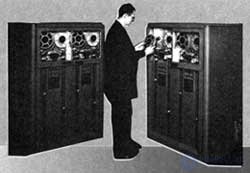Lecture
As if a well-fed, lazy giant, resting, but still looking around with one eye, IBM has been watching the development of computing equipment and input-output devices for some time, seemingly not reacting. Perhaps its leaders believed that when fundamentally new developments will be made by others, the company will be able to retain its position as a leader in the production of office equipment by simply adapting the new equipment to its profitable calculators on punched cards. Or maybe IBM executives were afraid to break the laws governing the pace of computer technology.
One way or another, but for a number of post-war years, IBM did not undertake any development in the field of computers, although it had previously participated in computer studies conducted at Harvard University and the Massachusetts Institute of Technology. Moreover, the company neglected the opportunity to buy Mauchly and Ekert before they turned to Remington Rand. IBM was considered so conservative that when one scientist, having left public service, decided to enter IBM, his colleagues warned him that “this card company will never make a single computer”.
However, few predictions are so far from reality. Throughout this period, hidden processes took place at IBM behind the scenes, and, oddly enough, it was the advances in the field of input-output devices that “woke up” the company. The company's engineers persistently sought to revive the administration’s interest in the computer revolution in progress, and finally, they managed to find an interested listener in the person of Thomas J. Watson, Jr., the vice-president of the company and the son of the chairman of its board. Watson Jr., a military pilot during the Second World War, was very impressed by the perfection of the radar and other military equipment he encountered in the army, and, obviously, he used all his influence to turn the company to face the latest advances in electronics .
By 1949, management had authorized work on the study of magnetic tape in order to find out the prospects for its use in office equipment systems, which brought the company huge profits. Some of the managers of the company doubted that the magnetic tape could be of any importance in the area of business machines - because unlike punched cards, which could be checked manually, magnetic tape testing required special equipment. In addition, IBM made huge investments - and it owned most of the patents - in the development of hardware on punch cards. However, research continued, and creating machines to test the capabilities of the magnetic tape, IBM engineers laid the foundations of its future in computing.

1952 In the IBM-701, the data was recorded on a plastic tape, which moved faster than a metal tape and to a lesser extent destroyed sensitive read-write heads.
In 1952, IBM introduced its first fully electronic digital computer, later named Model-701 (Model-701). Although punch cards were still used in this machine, it also included a whole range of new, promising I / O devices, including CRT monitors, high-speed line printers, and plastic tape drives. The first car was soon followed by the Model-702. Intended for widespread commercial applications, it provided options for entering data into a machine — from punched cards and from magnetic tape — as well as outputting information — to magnetic tape or to a printing device. By the mid-50s, the company's engineers had already been developing magnetic disks for storing information and the so-called data synchronizer, which controlled the interactions of computer peripheral devices and its central processor. Thus, the conservative giant and young science together stepped into the future.
Comments
To leave a comment
History of computer technology and IT technology
Terms: History of computer technology and IT technology